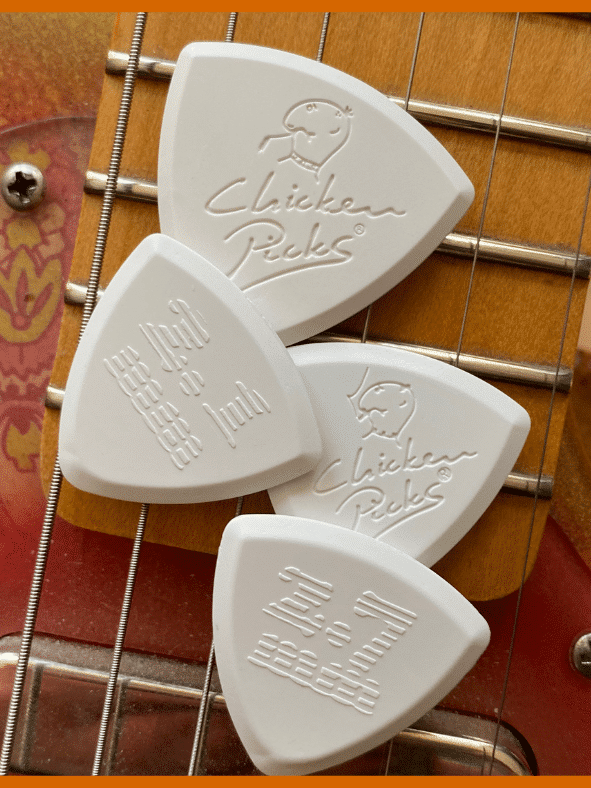Humbuckers vs single coil
Humbuckers vs single coil pickups for guitar.
Here we explain the differences of humbuckers vs single coil pickups, including the famous P-90 (single coil) pickups.
Pickups are magnetic devices that sense the vibrations of the strings and convert them into an electrical signal.
Each type of pickup has its character as well as your guitar and guitar amp have. The type of pickup you use will definitely affect guitar sound.
To learn more about how to make your guitar sound better, read our special on guitar tone.
The differences between pickups could be classified to the following characteristics:
- Tone:
Single-coils tend to sound bright, sharp, and clear.
Humbuckers offer a thicker and warmer tone with less noise. The output of most humbuckers is much higher, compared to single coil pickups. Of course the type of amp used, whether it is tube- or solid state drive does matter as well. - Output:
High output pickups produce a powerful signal, which can be useful for achieving more distortion or volume, especially used in rock or metal.
Lower-output pickups tend to have a cleaner, more dynamic response. Often preferred in genres like country, blues or jazz. The amount of headroom the amp delivers might be more important, but the pickups play an important role. - Noise: Single-coil pickups are more prone to electromagnetic interference (hum).
Humbuckers are designed to cancel out this noise. This offers a cleaner sound, especially at higher gain levels.
Humbuckers, single coil- and P-90 pickups.
Humbuckers, single coil pickups and P-90 pickups are collective names of a broad variety of pickups available nowadays.
And besides these pickups, there are many more types. But we will focus on the most common pickups for guitars.
When you would like to have a more “open” sound, rich with ambience and resonance, the type of pickup will definitely have its credits. But you would also like to find out the extreme differences between closed- and open back speaker cabinets for guitar.
History of guitar pickups
Single coil pickups
Somewhere around 1925 George Beauchamp, a guitar player from Los Angeles, Ca. began experimenting with electric amplification of his guitar.
He used a phonograph pickup assembly in the beginning. Later he began testing many different combinations of coils and magnets. The earliest coils were wound using a motor from a washing machine. Later he switched to a sewing machine motor, and eventually used single-coiled magnets.
Beauchamp was backed in his efforts by Adolph Rickenbacker, an engineer who owned a successful tool and die business. Beauchamp produced the first successful single coil pickup. It had two massive U-shaped magnets and one coil and was known as the “horseshoe pickup”.
Above is a typical Strat style single coil pick up. In many cases you will find 3 of them on a Strat style guitar.
With a 5-way switch there are settings which provide different sounds. 2 of them are so-called out of phase while most guitars have these 2 pickups combined in parallel. On the right side the actual coil with its windings of copper wire.
P-90 pickups
A P-90 is a single-coil pickup, invented and produced by Gibson starting in 1946.
Compared to Fender single coil pickups, the P-90 is wider and shorter. Due to that, the windings of the P-90 coil are shorter and a bit wider as well. The P-90 produces a little more warmth with less breakup and brightness.

P90 pickup as seen on many Gibson guitars before 1958.
Why humbuckers were invented
Unfortunately, “ground loop” noise (50 or 60 Hz hum) is, a common issue in audio systems.
A ground loop happens when various audio equipment are plugged into different AC outlets.
The ground loop acts as an antenna to pick up the stray magnetic fields of the power mains. These magnetic fields induce a current in the loop via electromagnetic induction. This is heard as the typical 50 or 60 Hz hum amplified.
P-90 pickups were perfect antennas for this 50 – 60 cycle hum and a terrible sound was created when turning an amplifier up. That is what they tried to “buck” in creating the humbucker pickups.
How humbuckers work
Humbuckers work by pairing a coil that has the north poles of its magnets oriented “up” with another coil alongside it with the south pole of its magnets oriented up.
By connecting the coils together out of phase, the interference is significantly reduced via phase cancellation.
Below a very simple explanation how the coils are wired in a humbucker.

In series
Humbucker pickups tend to be connected in series because that doubles the signal of the strings while keeping the hum reduced and avoiding an out of phase sound.
Humbuckers story
PAF pickups (short for “Patent Applied For”) are renowned for being the first humbucker. Although this isn’t really true.
Seth Lover was the man that invented the pickup for Gibson and filed for their patent in 1955.
Gretsch (Ray Butts) filed for their “Filter’Tron” patent in 1957. So, the race for humbucker pickups was on between these 2 companies and inventors.

Did Gretsch finally invent the humbucker?
Well, the race for humbucker pickups ended with two winners and two music-history-changing creations.
Sometime after making an amp for Chet Atkins in 1950, Ray Butts invented the Filter’Tron for Chet.
Shortly thereafter Seth Lover was hard at work on what would become Gibson’s first humbucker pickup, and then the lawyers would duke out the rest in court.
Gretsch awarded the patent of the humbucker
So, while Gibson filed first, it was Gretsch that was awarded the patent thanks to a recording of Chet Atkins playing those Filter’Tron pickups in 1954.

Gretsch 6120 (Brian Setzer) with TV-Jones humbuckers Filter’Tron style.
The main differences: PAF & (P-90) single-coil pickups:
P-90 Pickups
- Construction: P-90 pickups are single-coil pickups, having a wider coil and larger magnets than standard Fender type single-coils. They’re often described as having more output.
- Tone: P-90s have a punchy, mid-range-heavy sound with more warmth than standard single-coils. They sit somewhere between a single-coil and a humbucker in terms of tone. They can have a gritty, raw sound with a bit of growl, which makes them great for rock, punk, and blues.
- Noise: Like other single-coils, P-90s can be prone to hum and noise, but the wider coil helps to reduce this somewhat compared to traditional single-coils.
PAF Pickups:
- Construction: PAF pickups refer to the humbucker design that was first introduced in the late 1950s by Gibson. These pickups have two coils wound in opposite directions, which cancels out electrical hum and interference.
- Tone: PAF pickups are known for their smooth, warm, and balanced tone with a clear mid-range. They are less bright than single-coils and have a thick, round sound that’s perfect for classic rock, jazz, and blues. The output is typically moderate, giving a smooth overdrive when pushed.
- Noise: Because they are humbuckers, PAF pickups are much more quiet than single-coil pickups.
Single-Coil Pickups:
- Construction: Single-coil pickups have a single coil of wire wrapped around magnets. They are the simplest type of pickups.
- Tone: Single-coil pickups have a bright, sharp, and clear tone with a pronounced high-end. They’re known for their “twang,” making them ideal for genres like country, surf rock, and pop.
The tone is crisp and clear, but they can sometimes sound thin, especially when set to the bridge position. - Noise: Single-coil pickups are susceptible to electromagnetic interference, which causes the characteristic hum or buzz. This is a significant downside compared to humbuckers.
Fact about Fender Jazzmaster and P90 pickups
The P-90 bottom side (of the bobbin) has ceramic magnets. A typical Fender Jazzmaster pickup has 6 individual pole-piece magnets for each string.
An original P-90 has more grunt when you play hard, while a Jazzmaster has a thinner, papery sound and a classic twang.
There is more to guitar tone
Anything you are using as a guitar player has its role in the sound you create whether if it is the amp, the guitar, the pickups or anything else.
Many people forget that the guitar pick you are using, may be as important all other equipment.
The problem with many people that buy expensive guitars, even more expensive amplifiers and boutique fx pedals, is that the guitar pick used may not cost more than let’s say $1.00.
Cheap flexible plastic pick
For that amount of money you will get the cheapest rubbish plastic guitar pick you can imagine, while the guitar pick is the connection between the guitarist and his guitar. Read here why guitar picks should not be flexible.
Thick guitar picks deliver better tone and you will be able to have more control over the pick compared to thin pick.
Good thick guitar picks provide beveled edges, which allow you to glide across the string with ease.
ChickenPicks guitar picks has a variety of boutique picks that offer the best of both worlds according to tone and playability.
What others say about ChickenPicks guitar picks
Musikhaus Thomann
Chicago Music Exchange
Guitarpickreviews.com
Anatomy of guitar tone
Guitar essentials:
In guitar essentials we write about interesting things every guitarist should know a bit of, especially when you’re new to (electric) guitar.
We definitely don’t dig deep into theories or technical aspects.
You will find many scientific documents about anything somewhere on the internet.
Hi, my name is Eppo Franken and I started to make my own picks in the mid ’80’s.
In 2010 my wife Jolanda and I started ChickenPicks guitar picks, because we’d like to see if others would enjoy them as well.
I play guitar since 1980 and my favorite style is country chicken picking and some kinds of rockabilly and americana.
Send us an e-mail and let’s talk about guitar tone and picks




































